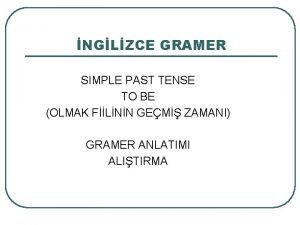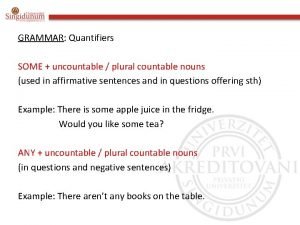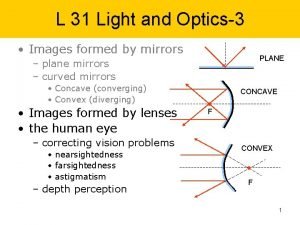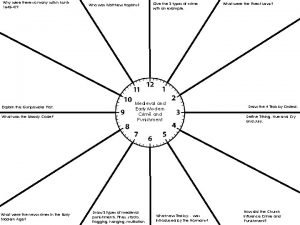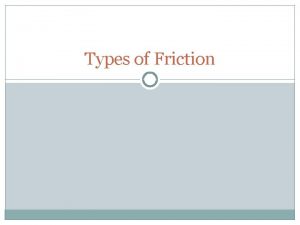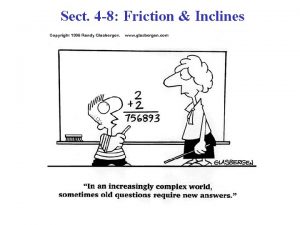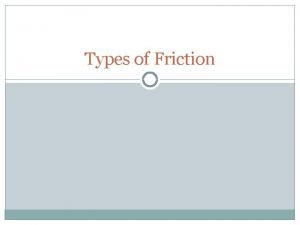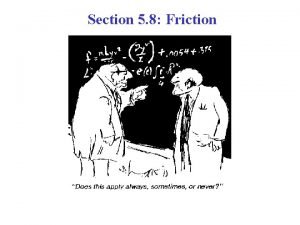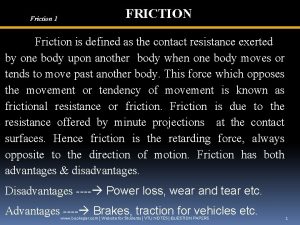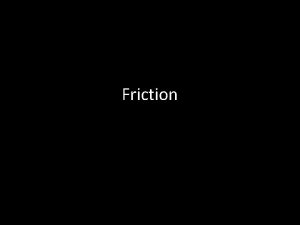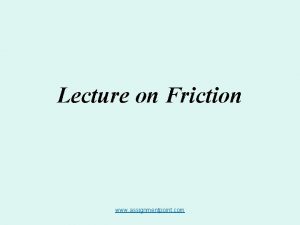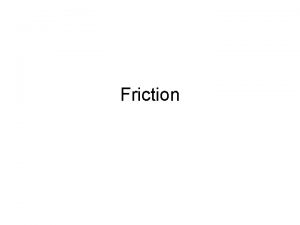What is Friction Why is there Friction Surface


























- Slides: 26

What is Friction? • Why is there Friction? Surface roughness Electronic interactions at the atomic level Examples of Friction - Desirable - Undesirable

Examples of Friction - Desirable - Walking - - Driving - Braking Undesirable - Engine Efficiency - Coasting - Pushing a heavy object

Why would I want to change friction? - How would I do it?

Friction & Applying Newton’s 2 nd Law System Chapter 6. 2

Friction • How does friction affect the motion of objects? – It can slow an object down like the friction between the tires and the road. – It is responsible for increasing the speed of an object like a car. – It is also responsible for objects being able to change direction.

Static Friction • Static Friction: – The resistive force that keeps an object from moving. Fground-on-crate Fforward Ffriction Fnet = Fforward – Ffriction Fforward Ffriction System Fgravity Since the crate is not accelerating, Fnet = 0 Fforward = Ffriction Note: As long as the crate does not move, Fforward = Ffriction

Kinetic Friction • Kinetic Friction: – The resistive force that opposes the relative motion of two contacting surfaces that are moving past one another. – Since the crate will initially accelerate, Fnet > 0. Fground-on-crate Ffriction Fforward Ffriction System Fgravity Fforward Fnet = Fforward – Ffriction Note: If the crate moves at a constant speed, then Fforward = Ffriction and Fnet = 0.

Determining the Frictional Force For people who had a lot of wrong ideas about Physics the Greek alphabet sure gets used a lot! • The force of friction is proportional to the normal • • • force and a proportionality constant ( - pronounced mu) called the coefficient of friction. FN For static friction: – 0 < Ff, static < s. FN For kinetic friction: Ff – Ff, kinetic = k. FN Note: FN = the force normal (perpendicular) to the frictional force on the object. is dimensionless Ff, static > Ff, kinetic

Determining the Frictional Force • (the coefficient of friction) is usually in the range of 0<= <= 1, but this is not always the case Material 1 Material 2 Tire, dry Road, dry 1 Tire, wet Road, wet 0. 2 Rubber Steel 1. 6 Teflon 0. 04 Ice Wood 0. 05 Glass Metal 0. 5 - 0. 7 Chromium Aluminum 0. 41 1. 3

The Normal Force • The normal force is a force that opposes the Earth’s gravitational attraction and is perpendicular to the surface that an object rests or is moving on. – For a horizontal surface, FN = Fg = mg. – For a surface that is not perpendicular to gravity, FN = Fgcos FN

The Normal Force FN Fg FN cos = adj/hyp Fg FN = Fg = mg FN = Fg cos = mg cos

What causes friction? • Friction is caused by the temporary electrostatic bonds created between two objects in contact with one another.

Example 2: Determining Friction (Balanced Forces) • Assume that the man in the figure is pushing a 25 kg wooden crate across a wooden floor at a constant speed of 1 m/s. – How much force is exerted on the crate? FN Fforward Ff System Fg

Diagram the Problem +y FN Fforward Ff System FN Fg y-direction: FN = Fg x-direction: Fnet = Fforward - Ff Fforward Ff Fg +x Since the crate is moving with constant speed, a = 0, Fnet = 0, and Fforward = Ff

State the Known and Unknowns • What is known? o Mass (m) = 25 kg o Speed = 1 m/s o Acceleration (a) = 0 m/s 2 o k = 0. 3 (wood on wood) • What is not known? o Fforward = ?

Perform Calculations • y-direction: o Fg = FN = mg • x-direction: a = 0 0 o Fnet = Fforward – Ff o Fforward = = Ff k. FN; Fforward = kmg (0. 3)(25 kg)(9. 8 m/s 2) 74 N

Example 3: Determining Friction (Unbalanced Forces) • Assume that the man in the figure is pushing a 25 kg wooden crate across a wooden floor at a speed of 1 m/s with a force of 74 N. – If he doubled the force on the crate, what would the acceleration be? FN Fforward Ff System Fg

Diagram the Problem +y FN Fforward Ff System FN Fg Fforward Ff Fg +x y-direction: FN = Fg x-direction: Since a > 0, Fnet = Fforward - Ff

State the Known and Unknowns • What is known? o Force = 148 N o Mass (m) = 25 kg o Speed = 1 m/s o k = 0. 3 (wood on wood) • What is not known? oa?

Perform Calculations • y-direction: o Fg = FN = mg • x-direction: a > 0 o Fnet = Fforward – Ff o ma = Fforward – kmg o a = Fforward – kmg m o a = (148 N)/(25 kg) – (0. 3)(9. 8 m/s 2) o a = 3 m/s 2

Determining the Frictional Force • (the coefficient of friction) is usually in the range of 0<= <= 1, but this is not always the case Material 1 Material 2 Tire, dry Road, dry 1 Tire, wet Road, wet 0. 2 Rubber Steel 1. 6 Teflon 0. 04 Ice Wood 0. 05 Glass Metal 0. 5 - 0. 7 Chromium Aluminum 0. 41 1. 3

Determining the Frictional Force For people who had a lot of wrong ideas about Physics the Greek alphabet sure gets used a lot! • The force of friction is proportional to the normal • • • force and a proportionality constant ( - pronounced mu) called the coefficient of friction. FN For static friction: – 0 < Ff, static < s. FN For kinetic friction: Ff – Ff, kinetic = k. FN Note: FN = the force normal (perpendicular) to the frictional force on the object. is dimensionless Ff, static > Ff, kinetic

Determining the Frictional Force • Sketch a graph of Fs vs applied force • Sketch a graph of Fk versus applied force • Sketch a graph showing the transition from Fs to Fk

Ff versus applied force

Ff versus applied force

Key Ideas • Friction is an opposing force that exists between two bodies. • Friction is proportional to the normal force and the coefficient of friction; static or kinetic. • The force required to overcome static friction is greater than that required to overcome kinetic friction.
 Why why why why
Why why why why Ali is climbing where does he need high friction
Ali is climbing where does he need high friction Don't ask why why why
Don't ask why why why Are impressions left by friction ridge skin on a surface
Are impressions left by friction ridge skin on a surface Whenever there is too little friction or traction
Whenever there is too little friction or traction Lateral surface area of a rectangular prism formula
Lateral surface area of a rectangular prism formula High surface tension vs low surface tension
High surface tension vs low surface tension Curved surface area of cone
Curved surface area of cone There is there are ejemplos
There is there are ejemplos There is there are part of speech
There is there are part of speech There is there are negative form
There is there are negative form There are there is
There are there is Some or any bananas
Some or any bananas There is there are
There is there are George and tamara (doesn't, don't) want to see that movie
George and tamara (doesn't, don't) want to see that movie Adjetivos demonstrativos
Adjetivos demonstrativos Some nerede kullanılır
Some nerede kullanılır Some any contables e incontables
Some any contables e incontables There is and there
There is and there There was there were ile ilgili cümleler
There was there were ile ilgili cümleler Exercising game
Exercising game There is there are
There is there are Hay there is there are
Hay there is there are Sightseeing countable or uncountable
Sightseeing countable or uncountable Ecological succession
Ecological succession Why does light not bend when it hits a curved surface
Why does light not bend when it hits a curved surface Why were there so many witch hunts 1645-47
Why were there so many witch hunts 1645-47



















